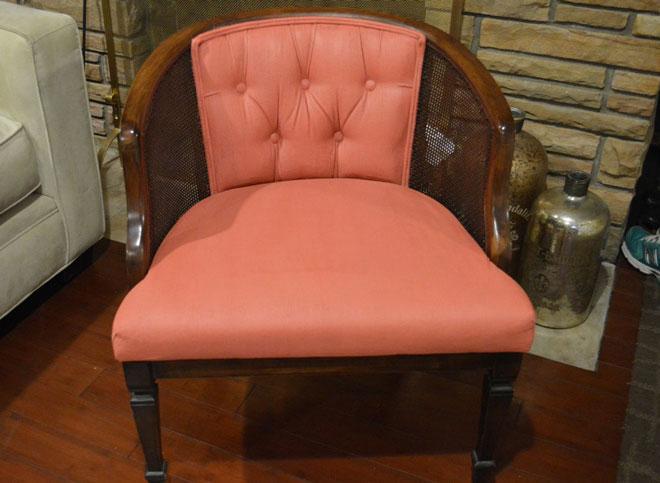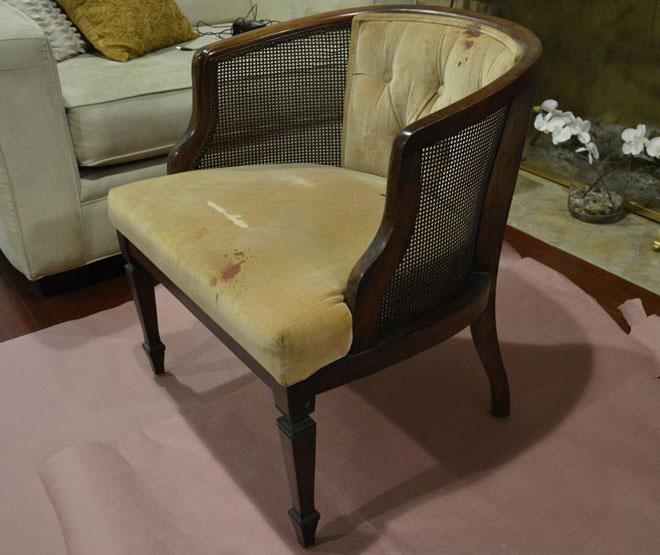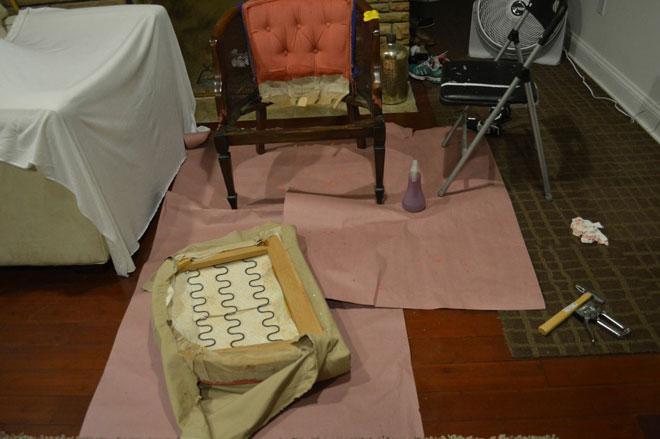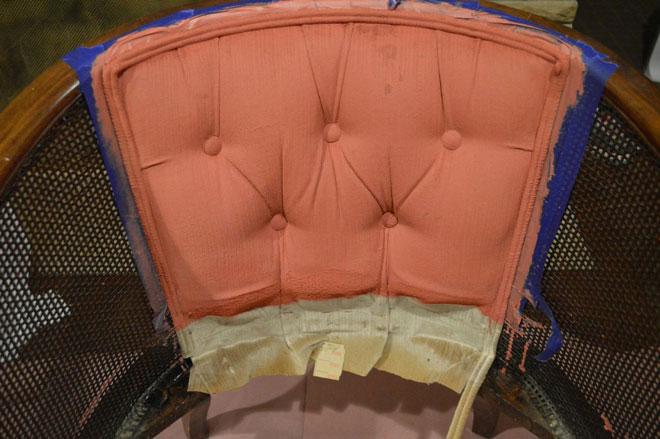How painting upholstery can easily renew a vintage barrel chair
I get excited every time I get a chance to talk about my DIY home projects and show people easy ways to make an old piece of furniture look beautiful without spending a ton of money. For my latest DIY project, I want to show you how the simple task of painting upholstery can renew a vintage barrel chair and transform it into a great piece for your home!

I originally purchased this chair about two years ago from my local thrift store for only 5. I remember setting it aside because I couldn’t figure out what I wanted to do to spruce it up. Recently, I found the chair buried under a bunch of junk in my basement. I finally came up with a plan to paint the upholstery on the chair.

Tools and materials for painting upholstery
- Paintbrush
- Paint stick or something to stir the paint with
- A medium-size plastic bowl or cup
- Drop cloth or other material to cover up the floor
- Tack hammer Paint (latex or acrylic)
- Staple gun
- Staples
- Fabric medium
- 3/4 yard of fabric
- An old rag
- Plastic spray bottle
- Water Painter’s tape (optional)
- Screwdriver
- Fine grit sanding sponge (180-grit or 220-grit)
Painting the fabric is pretty easy. Please keep in mind that there are variables to this DIY project. For example, the type of upholstery you’re working with and the type and finish of paint that you decide to use will ultimately affect how the fabric will feel once the project is complete.

Step 1: Preparation
First, clean the chair thoroughly to make sure there is no lint, dust or dirt, etc. Since the chair is a wood and upholstery combination, I used painter’s tape to cover up all of the wood areas that were close to the fabric to avoid getting paint on the wood. Note: this step is optional. On many occasions, I have wasted time prepping with tape, and I still ended up getting the paint where it wasn’t supposed to be. Really, the key is to take your time and be careful.
Next, make a paint mixture. Using a plastic bowl, I mixed two parts fabric medium, three parts paint and one part water. The majority of this mixture was used for the first and second coats of paint coverage. Be sure to use a paint stick to stir up the paint really well, and then fill the plastic spray bottle with plain water. Lay down a drop cloth in your work area. Set the chair on top of the covered area.

Step 2: Reupholster seat cushion
Turn the chair over and use a screwdriver to remove the seat cushion from the chair. Lay the fabric out on the floor with the outside of the fabric facing down. Cut the fabric down to size, leaving at least 2-3 inches of excess to be pulled over the cushion. Center the seat cushion on the fabric with the bottom of the cushion facing up.
Start by folding over one side of the fabric on to the cushion. Use the staple gun to secure the fabric to the seat cushion. Make sure the staples are not too close to the edge of the seat. The staples should be placed at least an inch apart. You definitely want to use enough staples so that the fabric is secured. If needed, use the tack hammer to make sure that the staples are pushed all the way into the wood.
Proceed to the opposite side of the cushion and repeat those same steps. Make sure to pull the fabric tight as you staple the second side. The fabric should be tight and hug the cushion. Move on to the remaining sides to complete the stapling, leaving the corners for last. For the corners, you may have to cut off excess fabric so that you are able to fold it down neatly without it looking bulky.
Once the seat cushion has been recovered, the painting can begin.

Step 3: Painting the upholstery
Start with the upholstery on the front of the chair. Use the spray bottle to saturate the fabric with water before applying the paint. The fabric needs to be wet in order to allow the paint to soak in. Plus, it helps thin the paint and ensures that the paint goes on smoothly. Once the fabric is wet enough, take the paintbrush and begin applying the paint to the fabric. When brushing on the paint, make sure that your last stroke always goes with the grain of the fabric. In those really tight areas, like around the button tufting, you may want to just go ahead and use your fingers to make sure the paint gets in all of the nooks and crannies.
Next, move on to the cushion. Use the spray bottle to saturate the cushion with water. Then, apply the paint. Wait and let the fabric dry over night before you apply the second coat of paint. Once the first coat is completely dry, you can then proceed to use the fine grit sanding sponge to lightly sand the fabric. Doing this loosens up and softens the fabric a bit, and it makes the surface smoother in case there are any dried clumps or patches.
Using the same steps above, spray the fabric with water again, then apply the second coat of paint. Let the second coat of paint dry. Once dry, sand again lightly.
By now, your first paint mixture should be gone. Mix up a second batch of paint. The final coat of paint should be a bit heavier coverage. I made a second batch for the final coat using one part fabric medium and two parts paint with no water this time. (Three coats of paint were required for this chair in order to cover all of the dark stains.) Lightly spray the fabric with water and then apply a thin layer of the final coat of paint. Finally, if you used painter’s tape, remove the tape from the chair before the paint dries. Once the paint dries on the tape, it will be more difficult to remove.

Step 4: Reattach seat cushion and clean up
Once the final coat of paint is dry, you can proceed to reattach the seat cushion to the chair. Make sure the seat is screwed in well, and use a slightly damp rag to wipe down the chair. Make sure there are no paint marks on the wood.
Step 5: Celebrate
Voila! You now have a chair that looks brand new, and it didn’t really cost you much except for getting your hands a little dirty.
